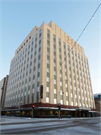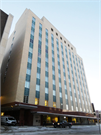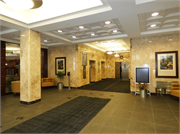Aid Association for Lutherans (AAL) Building
222 West College Avenue, Appleton, Outagamie County
Architect: Cram & Ferguson; Hoyle, Doran & Berry (1966 addition)
Dates of Construction: 1952, 1966 addition
The Aid Association for Lutherans (AAL) Building at 222 West College Avenue in downtown Appleton is significant in the areas of Commerce and Social History for its association with the Aid Association for Lutherans, a Lutheran Synodical Conference-affiliated fraternal benefit society incorporated in 1902 that grew to become the world’s largest fraternal insurance provider. Modeled after a traditional fraternal organization, AAL provided death, illness, and injury insurance to its customers, called “members,” who were drawn from churches belonging to the Lutheran Synodical Conference and in a manner that aligned with the values of their Lutheran faith. AAL first occupied the downtown Appleton site at the northeast corner of College Avenue and Superior Street in 1923 when AAL completed its first purpose-built headquarters. The current AAL Building required the demolition of the original 1923 building and was completed at this site in two phases – in 1952 and in 1966 – as an expression of the organization’s mid-twentieth century growth, its ranking as the world’s top fraternal benefit society and one of nation’s top insurance providers, and its important local role as one of Appleton’s largest employers. AAL used the College Avenue building as its main home office until 1977 and later as a secondary office site. In 2002, AAL merged with its chief competitor Lutheran Brotherhood to form the company Thrivent Financial for Lutherans, known simply as Thrivent, which continues to operate in Appleton today.
The AAL Building is also locally significant under Criterion C for Architecture as a rare and intact example of the Art Deco style in Appleton. The building’s original 1952 east block was designed by prominent Boston-based architects Cram & Ferguson, and its 1966 west corner addition was designed by Cram & Ferguson’s successor firm Hoyle, Doran & Berry. The AAL Building is an exceptional, though notably late, example of the Art Deco style popular in America in the decades before World War II, boldly displaying a stepped massing, emphasized verticality and horizontality, and a polychrome façade, all commonly associated with Art Deco.
In addition to its significance as AAL’s headquarters and an excellent example of the Art Deco style, the AAL Building has held the title of the tallest building in Appleton since 1952 and has been an important visual landmark in the city’s downtown commercial district for over 70 years. |





